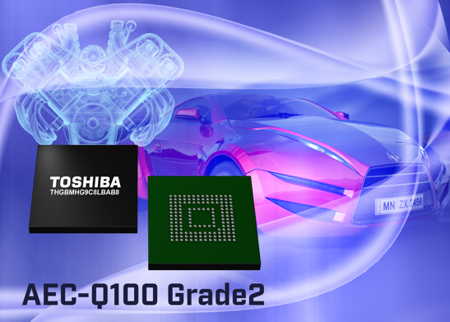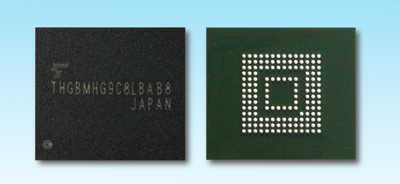Toshiba Expands Lineup of Embedded NAND Flash Memory Products for Automotive Applications
With JEDEC e-MMC V5.1 compliant embedded NAND flash memory products supporting AEC-Q100 Grade2 requirements
This is a Press Release edited by StorageNewsletter.com on December 29, 2016 at 1:52 pmToshiba America Electronic Components, Inc. (TAEC) announced the launch of JEDEC [1] e-MMC Version 5.1 [2] – compliant embedded NAND flash memory products supporting AEC-Q100 Grade2 [3] requirements.

This product lineup consists of densities of 8, 16, 32 and 64GB, and is suited to the requirements of the automotive infotainment market.
As consumer demand for connected cars grows, the need to support the storage demands of increasingly complex automotive applications for example, ADAS [4] and autonomous driving systems grows as well. Toshiba is meeting this demand by reinforcing its lineup of high-performance, high-density memory products.
In the automotive market, the development of car infotainment ADAS and autonomous driving systems has created an increased demand for NAND flash memory. Accelerated processing power and increased storage capacity are crucial to enabling these new technologies, and firm’s e-MMC has emerged as the storage technology of choice for automotive applications.

Company’s e-MMC parts integrate NAND chips and are fabricated using its 15nm process technology with a controller to manage basic control functions for NAND applications in a single package. The new products enhance Toshiba’s existing lineup of automotive e-MMC devices by offering support for applications such as instrument clusters, which require storage solutions that operate at higher temperatures (up to 105°C).
Product lineup:
|
Product Name |
Capacity |
Temperature Range |
Package |
|---|---|---|---|
|
THGBMHG6C1LBAB6 |
8GB |
-40°C ~105°C |
11.5x13x0.8mm |
|
THGBMHG7C2LBAB7 |
16GB |
-40°C ~105°C |
11.5x13x1.0mm |
|
THGBMHG8C4LBAB7 |
32GB |
-40°C ~105°C |
11.5x13x1.0mm |
|
THGBMHG9C8LBAB8 |
64GB |
-40°C ~105°C |
11.5x13x1.2mm |
Key features:
-
Handles essential functions, including bad block management, error correction and driver software.
-
Simplifies system development, allowing manufacturers to minimize costs and speed up time to market for new and upgraded products.
-
Enhances usability with new features [5] standardized in JEDEC e-MMC Version 5.1, including BKOPS control, cache barrier, cache flushing report, large RPMB write and command queuing.
-
Supports operational temperature range of -40°C to 105°C.
-
Meets AEC-Q100 Grade2 specifications.
Key specifications:
|
Interface |
JEDEC e-MMC V5.1 standard HS-MMC interface |
|---|---|
|
Capacity |
8, 16, 32, 64GB |
|
Power Supply Voltage |
2.7-3.6V (Memory core) 1.7V-1.95V, 2.7V-3.6V (Interface) |
|
Bus Width |
x1, x4, x8 |
|
Temperature Range |
-40oC to 105oC |
|
Package |
153Ball FBGA 11.5mm x 13.0mm |
The company is also currently developing automotive UFS [6] products that will support AEC-Q100.
Sample shipments of the new e-MMC devices begin now, with mass production scheduled for the second quarter of 2017.
Notes:
[1] JEDEC is a registered trademark of JEDEC Solid State Technology Association.
[2] e-MMC is a product category for a class of embedded memory products built to the JEDEC e-MMC standard specification and is a trademark of the JEDEC Solid State Technology Association.
[3] Electrical component qualification requirements defined by the AEC (Automotive Electronics Council).
[4] Advanced Driving Assistant System
[5] ‘BKOPS control’ is a function where the host allows the device to perform background operation when the device is idle. ‘Cache Barrier’ is a function that controls when cache data is written to the memory chip. ‘Cache Flushing Report’ is a function that informs the host if the device’s flushing policy is FIFO (First In First Out) or not. ‘Large RPMB write’ is a function that enhances the data size that can be written to the RPMB area to 8KB.
[6] Universal Flash Storage: Product category for a class of embedded memory products built to the JEDEC Standard specification.
Product density is identified based on the density of memory chip(s) within the product, not the amount of memory capacity available for storage by the end user. Consumer-usable capacity will be less due to overhead data areas, formatting, bad blocks, and other constraints, and may also vary based on the host device and application.














 Subscribe to our free daily newsletter
Subscribe to our free daily newsletter

